 This article on Rottweilers is part of a series to highlight the Big Picture of health, welfare, and breeding and to help develop Globally Relevant Integrated Health Profiles (GRIHPs) for many breeds. See IPFD's Get a GRIHP! on Breed Health Initiative.
This article on Rottweilers is part of a series to highlight the Big Picture of health, welfare, and breeding and to help develop Globally Relevant Integrated Health Profiles (GRIHPs) for many breeds. See IPFD's Get a GRIHP! on Breed Health Initiative.
There are many others doing great work to advance health, well-being, and welfare in this wonderful breed. We reference and link to terrific work, developments, reports, and research from the UK, USA, Sweden, Finland, and more below. Thanks to all of those working on behalf of Rottweilers.
This is a 'living document' - so if anyone has more material to share or point us to - please let us know!
Breed at a glance
 Rottweilers are intelligent, devoted working dogs. Their original purpose was to serve as drovers, draught dogs and guardians. Today’s dogs are trained to work as service, police, search and rescue, therapy, and military dogs; many fulfill roles as loyal family companions. These medium to high-energy dogs have guarding tendencies, so socialization and training are essential to ensure appropriate character development and behaviour. They require regular physical exercise and mental stimulation to thrive. These large, physically powerful dogs typically live from 8-12 years of age.
Rottweilers are intelligent, devoted working dogs. Their original purpose was to serve as drovers, draught dogs and guardians. Today’s dogs are trained to work as service, police, search and rescue, therapy, and military dogs; many fulfill roles as loyal family companions. These medium to high-energy dogs have guarding tendencies, so socialization and training are essential to ensure appropriate character development and behaviour. They require regular physical exercise and mental stimulation to thrive. These large, physically powerful dogs typically live from 8-12 years of age.
As a buyer or an owner, you might find websites that talk about different 'types' of Rottweilers. Terms used include American Rottweilers, German Rottweilers, Roman Rottweilers and Colossal Rottweilers and other 'types' as well. Basic common sense applies to getting and keeping these dogs. A well-bred Rottweiler adheres to the Breed Standard which describes the look and temperament of the breed. Check out Adrienne Farricelli's article, American, German, or Roman? The Different Types of Rottweilers for a more in depth look at Rottweiler 'types'. The last sentence of this article sums up the topic, "So, how many types of Rottweiler are ultimately there? The answer is two: the well-bred ones and the badly bred ones. The type you choose is ultimately up to you."
Key health conditions
CONTEXT: the list of key health conditions is based on a review of educational content and data available from, e.g., IPFD’s Kennel Club Partners and Rottweiler breed club websites; other veterinary practice data; and peer reviewed research. The health conditions are identified by experts, breed-health advisors, owners, and available evidence as those affecting health, quality of life, and welfare for affected individual dogs and/or creating issues and management challenges at a breed level. Key health conditions listed do not represent all health challenges in a breed, but are generally recognized as occurring or emerging in the breed; most are important to consider in breeding decisions. This section highlights key conditions - details, further data and more information, breed-specific programs for various conditions, the international breed population - and more - follows further below.
-
Rottweilers are affected by tumors, which are the most common cause of death in the breed. See references below.
-
Orthopedics: HD, ED, osteochondrosis, cruciate ligament damage
-
Heart disease: In the spring of 2017, International Federation of Rottweiler Friends (IFR) listed aortic stenosis (SAS), as a serious inherited disease in Rottweilers. Heart testing is recommended or required by several breed clubs. See more below.
-
Eye disease: hereditary cataract (HC), retinal dysplasia (RD), progressive retinal atrophy (PRA)
-
Reproduction system: testicle problems
-
Teeth: missing teeth, bite problems, jaw misalignment (shortening of the muzzle predisposes)
-
Epilepsy
-
Other key issues: exaggerated features See more on exaggerated features below.
More Info
See: Questionable Phenotypic Traits in the Rottweiler - Peter Friedrich 2018
Friedrich, Peter, 2018, Questionable Phenotypic Traits in the Rottweiler.pdf
Kennel Club acknowledgement of/actions to curtail exaggerated features:
Swedish RAS: In recent years, it has been noticed in several countries that the breed's muzzle has become shorter. Short muzzles can mean, among other things, difficulty breathing and misaligned teeth. In 2016, the Swedish Rottweiler Club introduced unofficial measurements of the muzzle and skull in connection with exterior descriptions. An initial compilation of the results from the breed club's measurements did not show a general problem with short noses, but the measurements continue until further notice. The problem with short muzzles, on the other hand, was considered to be so widespread in the breed that the In 2018, German breed club ADRK chose to update the breed standard for Rottweilers and clarify measuring conditions for skull and muzzle. Norway measures the muzzles: https://www.ifrrottweilers.org/news/news/norwegian-regulations-on-length-of-muzzle.html Finnish JTO: Exaggerated features appearing in Europe, including short muzzle, round skull, abundant skin and round eyes, have unfortunately reached the Finnish Rottweiler population. The shortening of the muzzles also results in noticeable changes in tooth positions, often transverse or overlapping due to overcrowding. Sweden, Finland, Norway - recommendation: breeding dogs to be inspected for exterior traits (ZTP) before first litter. Dogs with disqualifying bite defects and tooth deficiency should not be bred. Prioritize breeding that promotes good function and prevents the presence of undesirable traits in the offspring. The Nordic Breed Specific Instructions (BSI) regarding exaggerations in pedigree dogs: This [breed] group contains several brachycephalic breeds and also breeds of mastiff type as well as mountain dogs. It is of utmost importance that dogs are not of grotesque dimensions or overweight. They must have a sound, strong constitution in order to carry the typically heavy body and head according to the demands of the standards. They must move without effort or discomfort. Heavy breathing as well as overly heavy heads carried too low is incorrect in both small and large breeds. Narrow fronts, bent fore legs and weak pasterns as well as cow-hocks, lack of angulation or over-angulation in hind legs are incorrect for any breed but particularly important regarding the heavy breeds of group 2. The mastiff type dogs have excessive, loose skin which must never be exaggerated to cause skin, eye or lip problems. A dog’s skin must be healthy without any sign of discomfort.
What do caretakers need to know?
 Very important: mental traits! Every breed club stresses the importance of breeding from dogs that possess good character and working ability along with owner responsibility for development of proper working temperament and behaviour in these dogs. The dogs are described as powerful, alert, biddable, discerning, and even-tempered. Notes: the Nordic Breed Specific Instructions (BSI): Many breeds in the F.C.I.'s Group II (Pinscher and Schnauzer type, Molossian type, Swiss Mountain and Cattle Dogs) have a tendency towards mental sharpness and guarding/protective instincts. Typical breed characteristics should be preserved but must never exceed general basic recommendations for all breeds nor judicial regulations.
Very important: mental traits! Every breed club stresses the importance of breeding from dogs that possess good character and working ability along with owner responsibility for development of proper working temperament and behaviour in these dogs. The dogs are described as powerful, alert, biddable, discerning, and even-tempered. Notes: the Nordic Breed Specific Instructions (BSI): Many breeds in the F.C.I.'s Group II (Pinscher and Schnauzer type, Molossian type, Swiss Mountain and Cattle Dogs) have a tendency towards mental sharpness and guarding/protective instincts. Typical breed characteristics should be preserved but must never exceed general basic recommendations for all breeds nor judicial regulations.
Obedience training is a must for anyone who owns a Rottweiler. Locate a quality trainer/training class. Training should be undertaken early - when the dog is still a puppy to ensure the foundations for a good relationship that will make the dog a pleasure to live with; an outstanding family companion with manners.
Offer opportunities for physical exercise and provide an appropriate diet to ensure correct weight. Joint problems that are known to occur in large breeds are exacerbated by poor physical condition and excess pounds.
Statistics and Health Strategies
CONTEXT: We are pleased to be able to highlight a selection of internationally based Health Strategy Providers who offer content-rich statistics and in-depth, up-to-date information on health issues along with health strategies conceived to improve management of health and welfare for many breeds.
The websites for the Allgemeiner Deutscher Rottweiler-Klub e.V., Svenska Rottweilerklubben and the Suomen Rottweileryhdistys – Finlands Rottweilerförening r.y. (SRY – FRF) offer exceptional access to expansive breed-specific advice and health articles to aid buyers, owners, and breeders. A more complete listing of Rottweiler Breed Clubs located throughout the world is available on DogWellNet's Database page for the Rottweiler. Each Club's website offers value-added breed information. See the Breeding Strategies section below for further international information.
Population Statistics

North American Population
Rottweilers are a popular breed in the United States. Their AKC Rank has been steady at #8 over the past 5 years.

Health and Statistics
Agria - Swedish Breed Profiles

CONTEXT: For many years, Agria Animal Insurance, Sweden (Agria Djurförsäkring, Stockholm, Sweden) has supported veterinary research and provided statistics on diagnoses for health and life claims to Swedish breed clubs. See Breeds with Swedish Insurance Data and Agria Breed Profiles (where breeds are compared to All Breeds)! We recommend that you download the Agria Breed Profiles for the Rottweiler and study them for full available information. Some excerpts are shown below! The great benefits of the Swedish insurance data are that they include almost 40% of the national population of dogs, so are very representative; note that animals at very old ages are likely under-represented. Most importantly, information is available on all insured dogs, not simply those who get sick or die. This allows calculation of population-based rates (expressed as events per 10,000 years-at-risk) as well as risks and proportions. Statistics are presented as overall morbidity (rate of one or more veterinary care events [VCE]) or mortality (death), by general diagnostic categories, and by specific diagnoses.
The top three causes of Rottweiler deaths in 2011–2016:
-
Tumor
-
Musculoskeletal system
-
Stomach / intestine
The four main reasons for veterinary care in rottweilers in 2011–2016:
-
Musculoskeletal system: elbow problems (elbow dysplasia, FCP), ostechondrosis and cruciate ligament damage
-
Injury
-
Stomach / intestine
-
Neoplasia (tumors)
Notes: Back pain (degenerative lumbosacral stenosis, spondylosis) is something that has started to show up more and more often within the breed and is something to take into account when breeding.
Extracts from Veterinary Care Events Agria 2011-2016
Relative Risk Morbidity of Rottweiler compared to All Breeds: 1.37. (The risk in the Rottweiler is 1.37 times as high than for All Breeds.)


Extracts from Agria Breed Profile (Life) 2011-2016
Mortality - Relative Risk Mortality of Rottweiler compared to All Breeds: 2.46. (The risk in the Rottweiler is 2.46 times as high than for All Breeds.)


Additional information: Agria Breed Profiles 2011-2016 - VC and Life breed comparison



Finland: Rottweiler Mortality Data
Tumor diseases and cancer are by far the leading causes of death in Finnish Rottweilers. Almost third of the dogs reported dead died from cancer. The average life expectancy is 8 years 5 months. Young dogs also die to some extent, and in these cases most often it is skeletal or articular diseases.
Table: Longevity and causes of death in Finland - 2011-2021 (Finnish Kennel Club breeding database)

Rottweiler - Breed Specific Breeding Strategies
 COMMENT: Maintaining working traits and correct mentality is a primary concern in the Rottweiler breed throughout the world. Every breed club offers information and tests that document individual dog's capacity to perform as versatile working and reliable companion dogs. See below for particulars.
COMMENT: Maintaining working traits and correct mentality is a primary concern in the Rottweiler breed throughout the world. Every breed club offers information and tests that document individual dog's capacity to perform as versatile working and reliable companion dogs. See below for particulars.
Mental traits - Nordic Countries
Unacceptable behavior (Sweden, Finland): A dog that during show, test, competition, description or club-organized activity exhibits unacceptable behavior by showing aggression, doing outbursts or otherwise behave threateningly towards humans and / or other dogs or domestic animals, must be reported to kennel club by a special form.
Finland: Approved mental test or description mandatory for breeding dogs (not for service dogs), in order to get the litter registered by the kennel club. Also the companion dog temperament test BH (Begleithundprüfung) is recommended for breeding dogs.
Finnish JTO: Based on the results of the mental test, the breed has problems in functional capacity and nerves. Some dogs are also excessively soft, which is not desirable. One of the causes of death in young rottweilers is behavioral problems. The most common of these were insidiousness or unpredictability as well as viciousness – traits which are strongly interconnected. When assessing behavioral disorders, it would be good to know if the dog has had a physical condition and exhibited disruptive behavior caused by pain.
Sweden – recommendation: Mental description (MH) between 12 and 24 months of age and/or Korad. Breeding dogs should contribute to a better breed average according to the breed profile measured in MH. Do not to use for breeding dogs with handling problems.
Graph for average values of different parts of MH in Swedish Rottweilers (from Swedish RAS; Kontakt = contact; Lek = play; Jakt = chase; Grip = grabbing; Intresse = interest; Nyfikenhet = curiosity; Aktivitet = activity; Skott = gun shot; Rädsla = fear; Hot = threats, aggression):

Norway - recommendation: Approved FA (function analysis) or Mental Description (MH). MH must be performed between 12-24 months. Approved ZTP in accordance with ADRK's regulations Or approved MT (Korning) is considered satisfactory.
HGTD DNA Tests for Rottweilers
The Harmonization of Genetic Testing for Dogs (HGTD) Basics: The HGTD Searchable Database - Search by Breed, Search by Disease / Test and Search by Genetic Test Provider (GTP) / Lab + Genetic Counselling Resources. HGTD catalogs information provided voluntarily from genetic test providers (GTPs) including information on their company and services, quality measures and expertise, tests offered and more. As of January 2021, the HGTD Database includes 82 academic and commercial genetic test providers (GTPs) in 22 countries. Our searchable genetic phenes (phenes = characteristics/genetically controlled feature) database currently holds information on 300+ phenes across all breeds/types and provides information on each phene: links to the Online Mendelian Inheritance in Animals database (OMIA), gene + mutations, a simple and advanced disease description, inheritance details, links to original publications, patents/licenses, comments from the original researchers/experts on application, and breed specific information (such as research/validation) - where possible. Breed Relevance Ratings (BRR) support evidence-based usage and application of genetic tests. The HGTD database relevance rating indicates the level of available evidence supporting the application of a specific genetic test for a specific breed/type. Currently, the relevance rating is based on a wide variety of evidence sources. This includes peer-reviewed research papers, recommendations from the original researchers/test developers, input from additional experts including veterinary specialists, and breed experts. It is hoped that, by being more informative about what we currently know or do not know about a specific test for a specific breed, that dog health advisors and owners can make more informed decisions. Remember, this Breed Relevance Rating is not everything we need to know about the disease or characteristic; it is focused on the genetic test.
HGTD DNA Tests Rottweiler
 Also seeJLPP in Rottweilers - Dr. Peter Friedrich(1).pdf
Also seeJLPP in Rottweilers - Dr. Peter Friedrich(1).pdf
This article discusses the JLPP disease, its genetics, and availability of DNA testing as well as breeding advice.
The discovery of genetic causes of this disease (a monogenic autosomal recessive disorder) and subsequent development of a DNA test along with Dr. Friedrich's clear and concise explanation of genetics includes presentation of graphics with text of Pairing example 1 - homozygous normal X homozygous normal; Pairing example 2 - homozygous unaffected X heterozygous and finally Pairing example 3 - heterozygous X heterozygous. This article on JLPP clearly illustrates how this disease is produced and how it can be avoided which is very helpful to breeders who must implement a sound strategy to produce unaffected pups. JLPP - the DNA test has been recommended or required by breed clubs and appears to be one example of a solidly understood DNA test embraced by the breed fancy.
Links to additional JLPP information
Leukoencephalomyelopathy (LEMP) - Population testing of >200 Rottweilers indicates that the carrier rate of this mutation is ~8 % (USA). Not all Rottweilers with suspected LEMP have tested affected for this mutation. “It is possible that these dogs may be suffering from a different form of LEMP or the other neurodegenerative disase described in this breed - Neuroaxonal Dystropy." [University of Minnesota]
Myotubular Myopathy 1 (XLMTM) – in one Australian Rottweiler family: very rare.
Neuroaxonal Dystrophy (NAD) – rare.
Health Screening tests for Rottweilers
Finland
Orthopedics:
Hip dysplasia screening before mating is mandatory for breeding dogs, in order to get the litter registered by the kennel club. Grades D (moderate dysplasia) and E (severe) are not allowed for breeding. Estimated breeding values (EBV) in use from the year 2003 as a tool to decrease the frequency of hip dysplasia.
Hip dysplasia screening results by birth year (A = normal; B = borderline; C = mild; D = moderate; E = severe dysplasia):

Elbow dysplasia screening before mating is mandatory for breeding dogs, in order to get the litter registered by the kennel club. Grades 2 (moderate arthrosis) and 3 (severe) are not allowed for breeding. Estimated breeding values (EBV) in use from the year 2003 as a tool to decrease the frequency of hip dysplasia.
Elbow dysplasia screening results by birth year (0 = normal; 1 = mild; 2 = moderate; 3 = severe arthrosis):

Eyes:
Veterinary eye examination before mating is mandatory in order to get the offspring registered.
· Valid for 12 months if done at the age under 12 months, otherwise valid for 24 months. No re-examination needed if the dog has been examined at 7-years-of-age.
· Recommendation: a dog with an eye disease should be mated only with a dog with completely healthy eyes.

Heart conditions:
According to the health questionnaire of the Finnish breed association, approximately 5 % of dogs had been diagnosed with heart failure or disease. A congenital murmur of heart had been found in about half of these dogs. Half of the diagnosed dogs died of cardiac arrest. In most cases, the causes of sudden death have not been elucidated. In the future, it would be good to find out the pathological cause of the cardiac arrest. A research project is underway.
Other health problems:
According to breed association’s survey results (2019), the most common health problems are dental problems (8.8 % of dogs), prostate enlargement or inflammation of the prostate (8.6 %), skeletal and joint problems (8.4 %), heavy signs of false pregnancy (8.1 %), cruciate ligament rupture (6.5 %), tumors (6.3 %), recurrent skin problems / atopy (4-6 %) and spondylosis (3.2 %).
Dogs with insufficient hind angulation exist; this may affect cruciate ligaments and cause ruptures.
The breed association does not recommend the use of breeding dog with
-
cruciate ligament problems
-
osteochondrosis
-
skin problems
-
spine problems
-
testicular defects
-
dental defects
-
autoimmune diseases
-
digestion problems or sensitive stomach
-
epilepsy
-
a combination which has produced epileptic offspring may not be repeated. The use of siblings of an epileptic dog should occur at as high age as possible.
Sweden
Hip dysplasia screening: A (normal) and B (borderline) approved for breeding. Estimated breeding values (EBV) in use from the year 2012 as a tool to decrease the frequency of hip dysplasia.
Hip dysplasia screening results by birth year (grad A = normal; B = borderline; C = mild; D = moderate; E = severe dysplasia):

Elbow dysplasia screening before mating is mandatory for breeding dogs, in order to get the litter registered by the kennel club. Only the result 0 (normal) is approved. Estimated breeding values (EBV) in use from the year 2012 as a tool to decrease the frequency of elbow dysplasia.
Elbow dysplasia screening results by birth year (ua (0) = normal; grad 1 = mild; 2 = moderate; 3 = severe arthrosis):

Recommendations for breeding dogs:
-
Epilepsy: do not use affected individuals in breeding
-
Wait with the breeding debut in siblings of a sick dog until they are 3.5–4 years old
-
Cranial cruciate ligament ruptures:
-
Do not use affected individuals in breeding; avoid mating two individuals with close relatives (parents/siblings) suffered from cruciate ligament problems
-
Dogs with a medication for chronic disease should not be bred.
-
Breeding bitches should have normal heats and be willing to mate
Norway
The following criteria must be met for dogs to be used in breeding:
-
Free of hip dysplasia and elbow dysplasia. If one of the dogs to be mated has a degree 1 elbow dysplasia (borderline or mild arthrosis), the partner must be free (0). In addition, dogs used in breeding should
-
be from litters where the incidence of HD and AD is not greater than the average for the breed
-
males: after having 30 offspring, should not be bred more until a minimum of 50 % of the offspring are screened for HD and ED. The male dog should only be used further if the offspring are better or equal to the average of the breed.
Estimated breeding values (EBV) in use from the year 2008 as a tool to decrease the frequency of hip dysplasia.
Recommended: eye check


Breeding age
Finland mandatory, Norway and Sweden recommendation: Dogs to be used in breeding must be 24 months old.
UK - The Kennel Club
Priority health schemes and tests
The Kennel Club Assured Breeders (ABs) must use the following (or equivalent) schemes, tests and advice. All other breeders are strongly advised to also use these.
Important health schemes and tests
We strongly recommend that all breeders, both assured breeders (ABs) and non ABs, use the following (or equivalent) schemes, tests and advice.
-
Bitches not to produce a litter under 2 years of age
-
Bitches not to produce more than one litter within a 12-month period
-
Check inbreeding calculators
Other health schemes and tests available
Source: https://www.thekennelclub.org.uk/search/breeds-a-to-z/breeds/working/rottweiler/
US
 Please note, there are several Rottweiler clubs in the US.
Please note, there are several Rottweiler clubs in the US.
OFA-CHIC Health Testing Requirements
The OFA, working with the breed's AKC parent club, recommends the following basic health screening tests for all breeding stock.
OFA Statistics are available: See the Breed Summary report...ROTTWEILER.pdf and Eye Testing: Blue Book
Source: https://www.ofa.org/recommended-tests?breed=RO
Other US-based Rottweiler Clubs
USRC Breeding Regulations - Breed Tests
Rottweiler Klub of North America - USA - Breed Suitability Evaluation Tests
-
The Ztp (Zuchttauglichkeitsprüfung) is designed to select those Rottweilers who are worthy of being bred. The dog’s conformation must be judged of breeding quality and free of disqualifying faults. The dog must have a passing hip rating and permanent identification (tattoo or microchip). Once the conformation and soundness qualifications have been met, the dog’s temperament is tested. This test includes a gun sureness test, a protection test, and a test to ensure the dog is stable around the public. The Rottweiler Klub of North America strongly believes that these tests are vital to maintaining the Rottweiler in type and temperament and should be the foundation of any breeding program.
United Rottweiler Klub of America Inc. URKA - Tests
-
The Ztp (Zuchttauglichkeitsprüfung) is designed to select those Rottweilers who are worthy of being bred. The dog’s conformation must be judged of breeding quality and free of disqualifying faults.
Note: Hips, Elbows, Heart and JLPP tests along other qualifications/evaluations are included in these club's recommendations/requirements for breeding dogs/participation in events.
Genetic Diversity in Rottweilers - Research and Reports
Overview of the Nordic Club's Approach to Genetic Diversity
Inbreeding
Maximum recommended inbreeding coefficient for litters:
-
Sweden 7 %
-
Norway 6.25%
-
Finland 6.25 % (calculated over four generations).
Sweden (Inavelsgrad = average inbreeding coefficient):

Finland (Sukusiitosaste = average inbreeding coefficient)

Number of Offspring
Maximum recommended number of offspring per individual dog:
-
Sweden: the number that corresponds to 10 % of the yearly registered dogs.
-
Males: Max 5 litters/year
-
Norway: after having 30 offspring, a male should be restricted from breeding until a minimum of 50% of the offspring are screened for hip and elbow dysplasia. The male dog should only be used further if the offspring are better or equal to the average of the breed.
-
Finland - offspring registration limit: the number of registered offspring of an individual dog during its lifetime may not exceed sixty (60). The litter with which the limit exceeds, can be registered in full.
-
Raising the quota to 100 offspring may apply when the following criteria are met:
-
At least 50% of the offspring have a screening result for hip and elbow dysplasia and eye disease.
-
At least 25% of the offspring have a mental test/mental description result.
References and Resources
 DogWellNet's Resources
DogWellNet's Resources
Research: UK Vet Compass
O’Neill, D.G., Seah, W.Y., Church, D.B. et al. Rottweilers under primary veterinary care in the UK: demography, mortality and disorders. Canine Genet Epidemiol 4, 13 (2017). https://doi.org/10.1186/s40575-017-0051-7
Illustrated Standards-Study Guides/Compendiums
ADRK: anatomy and movement of the Rottweilers & Tails
The American Rottweiler Club Judges Education packet
Links to documents used in preparing this GRIHP
IPFD and The World Small Animal Veterinary Association
See our series of Meet the Breed articles in the WSAVA Bulletin and associated Get a GRIHP! Articles on DogWellNet.com:
-
Welsh Corgi
-
Dachshund
-
French Bulldog


-
Australian Shepherd
-
Saluki
-
Golden Retriever
-
Bernese Mountain Dog
-
Black Russian Terrier
-
Pug
-
Finnish Spitz
-
Rhodesian Ridgeback
-
Rottweiler
-
Whippet
-
Belgian Shepherd
-
English Bulldog
-
Irish Soft Coated Wheaten Terrier
-
Dalmatian
-
Border Terrier
-
Staffordshire Bull Terrier
-
Siberian Husky
-
Dobermann
-
Shih Tzu
-
English Setter
-
Beagle
-
Chihuahua
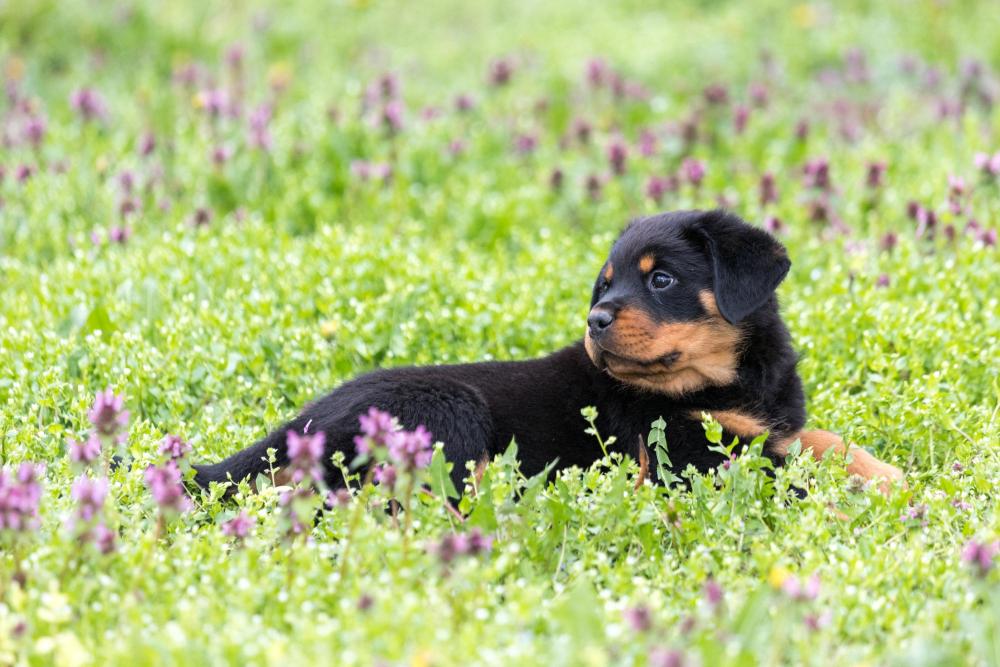 This article on Rottweilers is part of a series to highlight the Big Picture of health, welfare, and breeding and to help develop Globally Relevant Integrated Health Profiles (GRIHPs) for many breeds. See IPFD's Get a GRIHP! on Breed Health Initiative.
This article on Rottweilers is part of a series to highlight the Big Picture of health, welfare, and breeding and to help develop Globally Relevant Integrated Health Profiles (GRIHPs) for many breeds. See IPFD's Get a GRIHP! on Breed Health Initiative.
 Donate
Donate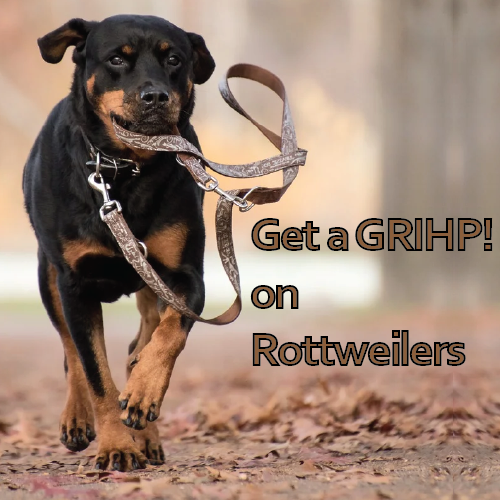
 Rottweilers are intelligent, devoted working dogs. Their original purpose was to serve as drovers, draught dogs and guardians. Today’s dogs are trained to work as service, police, search and rescue, therapy, and military dogs; many fulfill roles as loyal family companions. These medium to high-energy dogs have guarding tendencies, so socialization and training are essential to ensure appropriate character development and behaviour. They require regular physical exercise and mental stimulation to thrive. These large, physically powerful dogs typically live from 8-12 years of age.
Rottweilers are intelligent, devoted working dogs. Their original purpose was to serve as drovers, draught dogs and guardians. Today’s dogs are trained to work as service, police, search and rescue, therapy, and military dogs; many fulfill roles as loyal family companions. These medium to high-energy dogs have guarding tendencies, so socialization and training are essential to ensure appropriate character development and behaviour. They require regular physical exercise and mental stimulation to thrive. These large, physically powerful dogs typically live from 8-12 years of age.
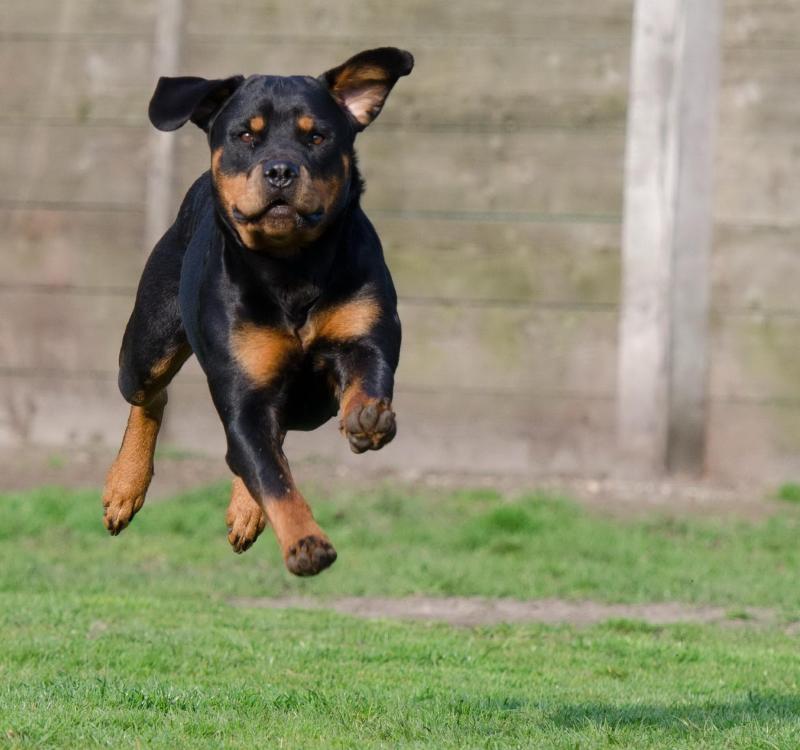
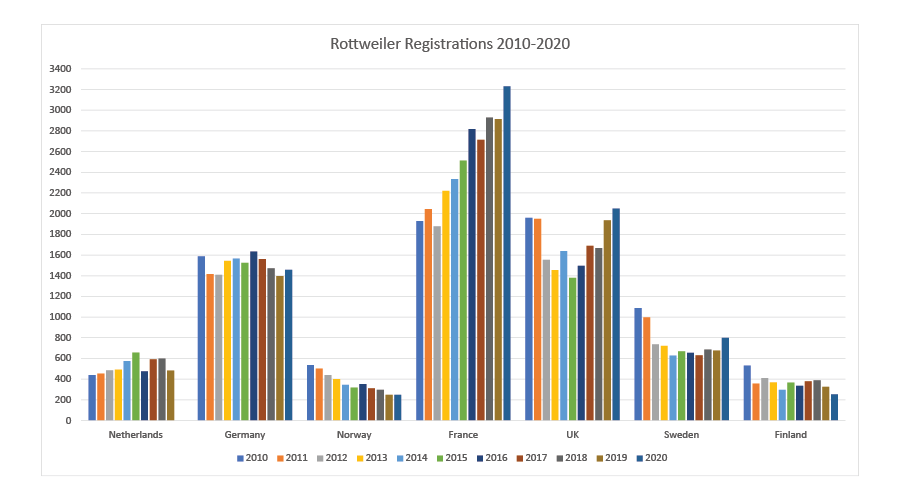


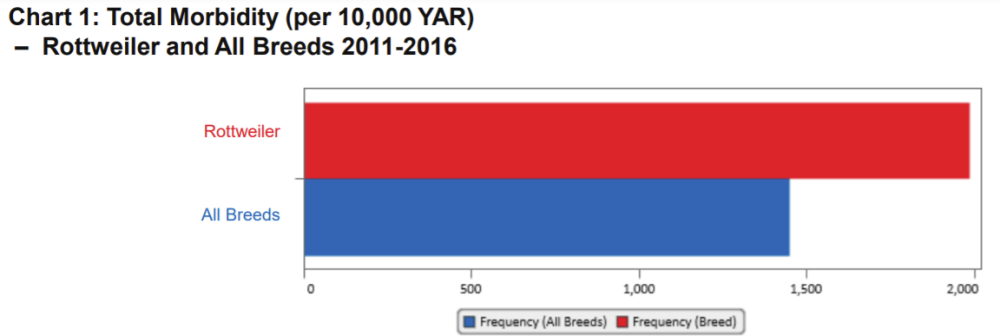
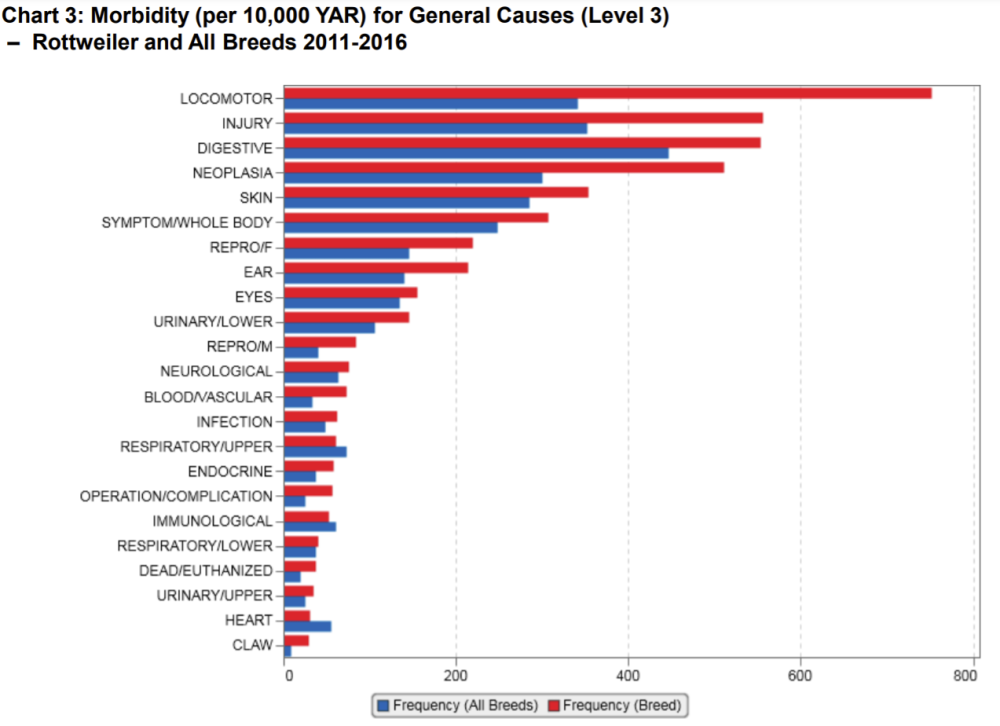

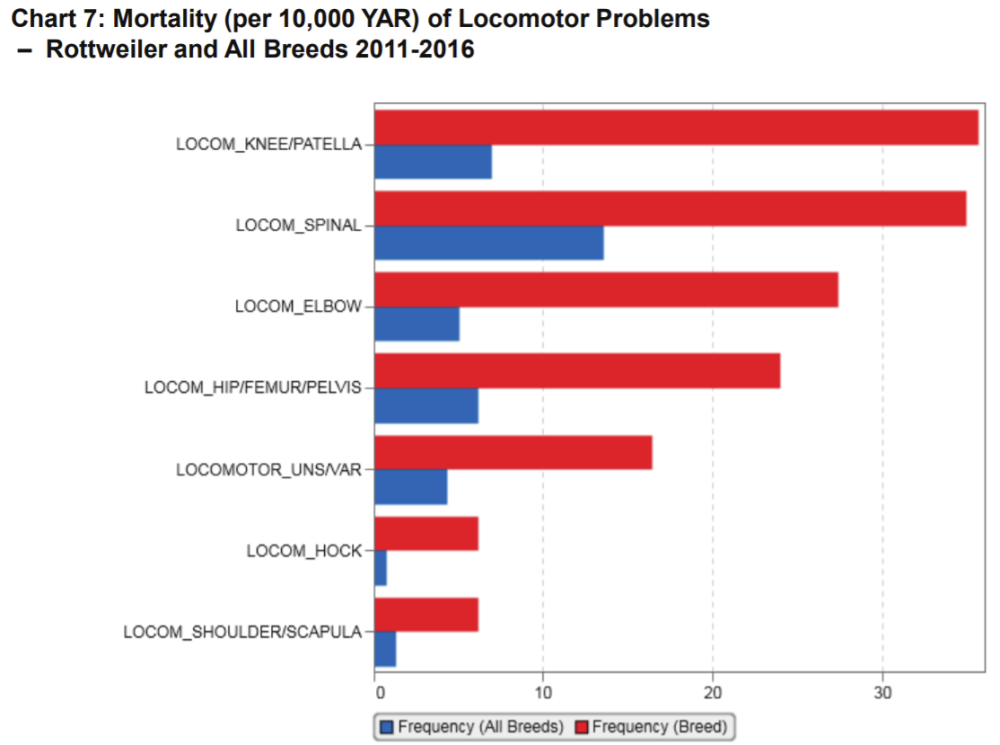
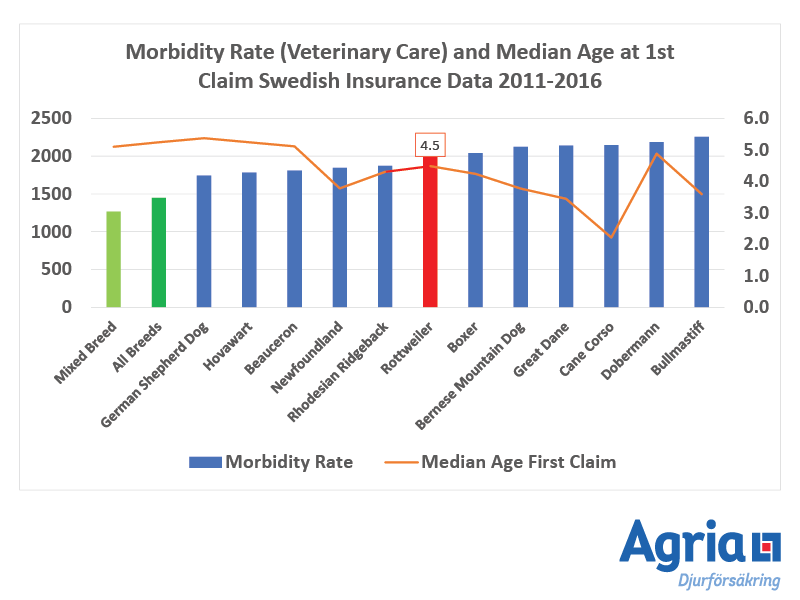
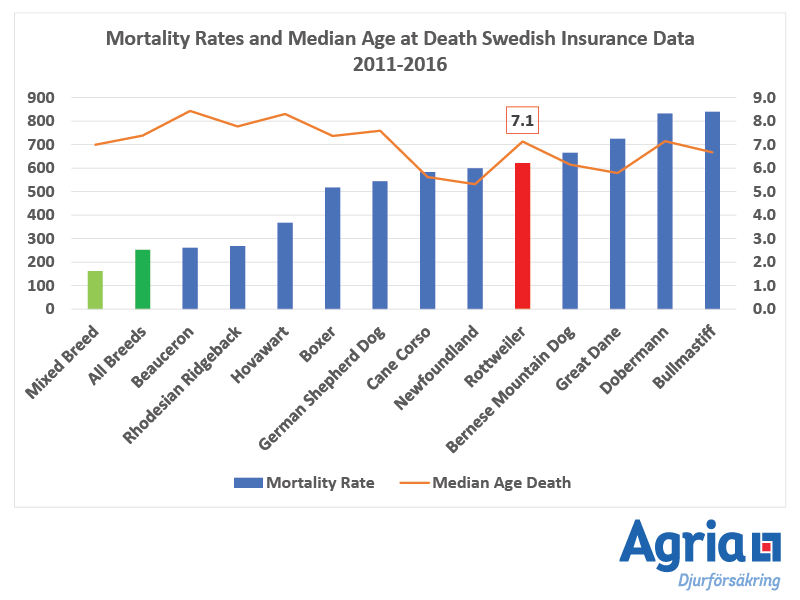

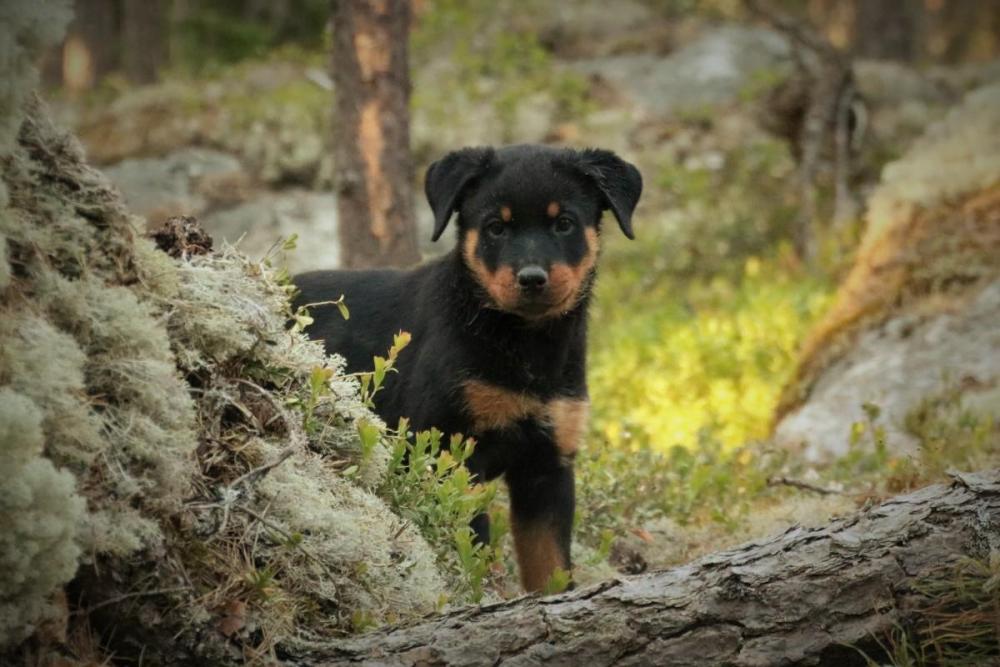
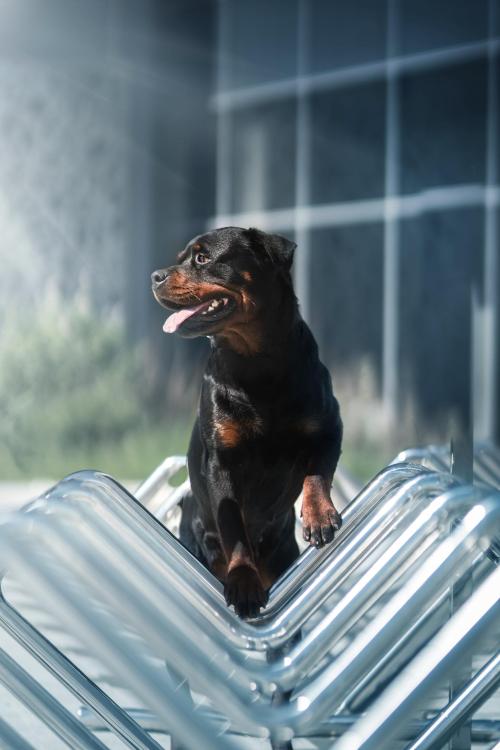



Recommended Comments
There are no comments to display.
Join the conversation
You can post now and register later. If you have an account, sign in now to post with your account.
Note: Your post will require moderator approval before it will be visible.